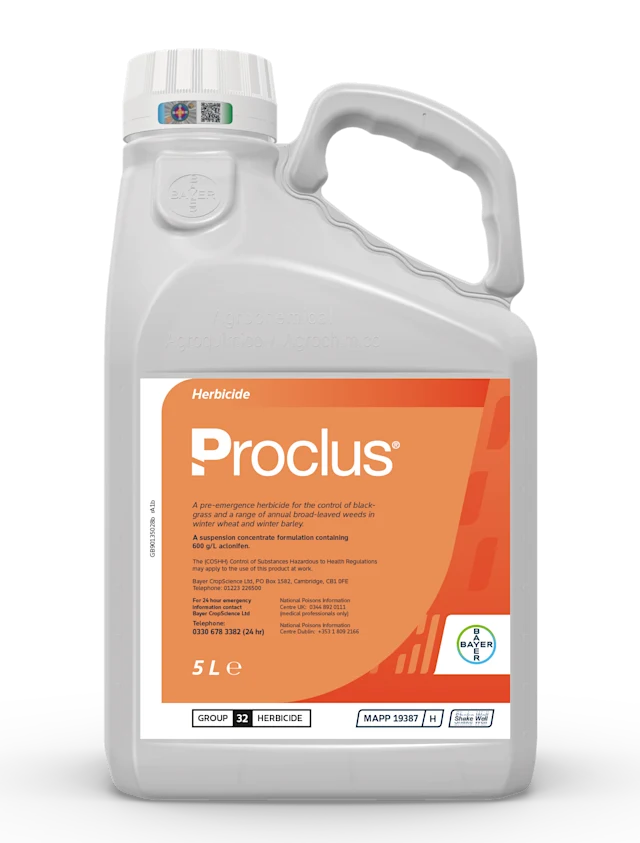

Proclus®
A highly effective residual herbicide for the control of black grass, Italian rye-grass, brome and other grass weeds and broadleaf weed species. For use in winter wheat and winter barley.
Product details
Effective autumn control is a key step in controlling black grass, Italian rye-grass and other grass weeds. Proclus is approved for pre-emergence and post-emergence use in both winter wheat and winter barley.
Use in a tank-mix with other chemistry such as Liberator®, Alternator® Met, Cadou® Met or Octavian® Met. It can also be mixed with prosulfocarb and pendimethalin to good effect.
Proclus acts on the shoots as they emerge. When applied it forms a film on the soil surface to control emerging shoots. This site of activity complements flufenacet which is soil mobile and works on the roots.
Aclonifen is less reliant on soil moisture for efficacy than some other actives, so it still achieves good control in drier conditions. It is also moderately persistent, protecting crops from late emerging weeds during autumn.
In wheat, you can apply the full rate (1.4 l/ha) Proclus pre-em. or split the dose and apply 1l/ha pre-em. followed by 0.4l/ha post-em.. You can also use 0.4l/ha Proclus post-em. even if you did not apply Proclus earlier in the programme.
In barley, you can apply 1l/ha Proclus at pre-em. and follow up with 0.4l/ha Proclus. In both wheat and barley, the maximum total dose is 1.4 l/ha.
At pre-em., use Proclus in a tank-mix with other chemistry. Apply within 48 hours of drilling to a fine, consolidated seedbed free of trash or clods. Aclonifen is not as dependent on soil moisture as actives like flufenacet in Liberator so there is potentially a little more flexibility to use in dry conditions. However, the best results still come when applications are made with a little soil moisture around.
A split dose of Proclus with 1l/ha at pre-em. followed by 0.4 l/ha at post-em. is a good additional option to increase longevity in the herbicide programme and have a robust post-em. tank-mix.
Before using Proclus, make sure that suitable cultural controls are in place. Delay drilling as late as reasonably possible, ideally mid–late October depending on location, which helps to reduce weed germination in the crop.
Drilling and applying herbicides in October means that residual protection extends further into autumn because cooler, shorter days increase the longevity of pre-em. herbicides which degrade due to light and heat.
At pre-em. apply Proclus with Liberator or a Metribuzin co-form like Alternator Met, Cadou Met or Octavian Met for excellent all-round control of grass weeds and broadleaf weeds in winter wheat and winter barley
Alternatively, in wheat or barley, use 1l/ha of Proclus at pre-em. followed by 0.4l/ha at post-em.
Ensure the pre-em. application goes on at the true pre-em timing, ideally within 48 hours of drilling.
Apply uniformly to a fine, firm seedbed to form a homogenous layer.
Do not disturb the soil after application as this will affect the efficacy of the products.
Observe drilling depth requirements on product labels (32 mm of settled soil for).
Apply using a horizontal boom sprayer, in 200-400 litres of water per hectare as a MEDIUM spray (BCPC category).
For split doses in wheat, ensure suitable mix partners are used at both timings.
In barley use1 l/ha Proclus plus Liberator for pre-em. weed control.
Aclonifen is a unique mode of action, the only member of HRAC Group 32. It is still relatively new for UK agriculture and has no known resistance problems. Used in partnership with flufenacet, it helps protect flufenacet from further resistance and sensitivity shifts that have already been identified on some farms.
Other actives such as metribuzin, prosulfocarb and pendimethalin can be safely mixed with aclonifen to improve control and prevent resistance. Always use Proclus within an integrated programme that uses diverse modes of action and non-chemical methods to control weeds.